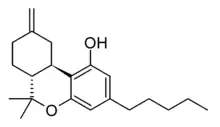Delta-11-Tetrahydrocannabinol
Delta-11-Tetrahydrocannabinol (Delta-11-THC, Δ11-THC, Δ9(11)-THC, exo-Tetrahydrocannabinol) is a synthetic isomer of tetrahydrocannabinol, developed in the 1970s. It can be synthesised from Δ8-THC by several different routes,[1][2][3] though only the (6aR, 10aR) enantiomer is known. In animal studies it was found to be active in mice with around 1/4 the potency of Δ9-THC,[4] but did not substitute for THC in rhesus monkeys, probably because the dose tested was not high enough to produce cannabinoid-like effects.[5][6] It has been identified as a component of "vaping liquids" sold for use in humans.[7]
 | |
| Identifiers | |
|---|---|
| |
| CAS Number |
|
| PubChem CID | |
| Chemical and physical data | |
| Formula | C21H30O2 |
| Molar mass | 314.469 g·mol−1 |
| 3D model (JSmol) | |
| |
| |
See also
References
- Wildes JW, Martin NH, Pitt CG, Wall ME (March 1971). "The synthesis of (-)-delta-9(11)-trans-tetrahydrocannabinol". The Journal of Organic Chemistry. 36 (5): 721–723. doi:10.1021/jo00804a024. PMID 5545571.
- Banijamali AR, Makriyannis A (1998). "Novel synthesis of (−)-trans-Δ9,11-tetrahydrocannabinol". Journal of Heterocyclic Chemistry. 25 (3): 823–825. doi:10.1002/jhet.5570250324.
- Banijamali AR, Van Der Schyf CJ, Makriyannis A (1998). "Addition and elimination of HCl to tetrahydrocannabinol isomers. A method for the preparation of stereospecifically 2H-labeled cannabinoids". Journal of Labelled Compounds and Radiopharmaceuticals. 41 (2): 121–130. doi:10.1002/(SICI)1099-1344(199802)41:2<121::AID-JLCR55>3.0.CO;2-S.
- Compton DR, Prescott WR, Martin BR, Siegel C, Gordon PM, Razdan RK (November 1991). "Synthesis and pharmacological evaluation of ether and related analogues of delta 8-, delta 9-, and delta 9,11-tetrahydrocannabinol". Journal of Medicinal Chemistry. 34 (11): 3310–3316. doi:10.1021/jm00115a023. PMID 1659638.
- Beardsley PM, Scimeca JA, Martin BR (May 1987). "Studies on the agonistic activity of delta 9-11-tetrahydrocannabinol in mice, dogs and rhesus monkeys and its interactions with delta 9-tetrahydrocannabinol". The Journal of Pharmacology and Experimental Therapeutics. 241 (2): 521–526. PMID 3033218.
- WHO Expert Committee on Drug Dependence Critical Review. Isomers of THC (PDF) (Report). World Health Organization. 2018.
- Ciolino LA, Ranieri TL, Brueggemeyer JL, Taylor AM, Mohrhaus AS (2021). "EVALI Vaping Liquids Part 1: GC-MS Cannabinoids Profiles and Identification of Unnatural THC Isomers". Frontiers in Chemistry. 9: 746479. doi:10.3389/fchem.2021.746479. PMC 8499677. PMID 34631667.
This article is issued from Wikipedia. The text is licensed under Creative Commons - Attribution - Sharealike. Additional terms may apply for the media files.